By Jackie McFarland
Katherine Bardis
A senior at Loyola Marymount with Law School aspirations, Katherine Bardis is growing up. Considering she has only been in the jumper ring since age 14 and in the Grand Prix arena since age 17, she made a name for herself in a short span of time. Now 22 years old (for about a week at press time), Katherine is making adult decisions about her riding, her education and her career.
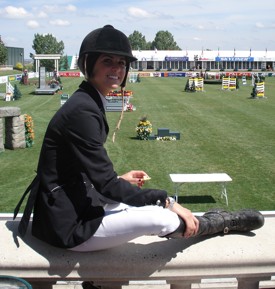 EqSol: Your equestrian start – where you are from, how you started riding, the early years…
EqSol: Your equestrian start – where you are from, how you started riding, the early years…
KB: I started when I was about 10 years old. My older cousins rode and loved watching them but my parents would not let me start until I had tried out other sports first. I’m from Pebble Beach so the Pebble Beach Equestrian Center was almost walking distance from our house. My first lessons were with Toni Venza and Tracy Cotchett. I started in the medium ponies, then moved to the greatest large pony ever, ‘Peter Piper’ (PD) who we leased from Alex Silvestri. When I was 12, I won the Pony Finals on PD and then got my first Children’s Hunter, a little quarter horse named ‘Equal.’
EqSol: When did you know you wanted to ride in the jumpers?
KB: I was getting bored doing hunters and equitation. My mom really didn’t want me to do the jumpers because she knew once I started I would be hooked, which is exactly what happened. When I was 14, we went to Spruce Meadows just for fun with a couple of my equitation horses – my trainer thought it would be a good experience. That was when my dad and my trainer’s husband met Richard Spooner in the show office. Of course he was my idol, since we had just watched him win the Queens Cup and the Chrysler Classic. So I was extremely embarrassed that they were talking to him. Luckily, during their conversation (while I was timidly hiding in the corner) Richard mentioned that he had some horses for sale and that we should come and try them. And that’s how it all began…
We flew down from Pebble Beach to the Los Angeles Equestrian Center and ended up purchasing two horses, Prestige and Bada Bing. Within a month, I started riding with Richard. We went down on the weekends so I could train and go to shows with him. I hadn’t had any formal jumper training nor had I been competitive in the jumper ring before Prestige and Bada Bing, so when I started riding with Richard it was like a whole new world.
EqSol: When did your Grand Prix aspirations start?
KB: I didn’t have Grand Prix aspirations until I was about 17. That’s when I rode in my first Friday Grand Prix in Indio on Mademoiselle and Pariska. I remember I was so nervous because it was not only my first Grand Prix but theirs too. Luckily they were both fantastic. I think I ended up 10th on Pariska.
EqSol: Your GP history – when you started, the good, the bad & the victories.
KB: After Indio in 2005, I wanted to try and keep riding at the Grand Prix level. In 2007 I was a freshman in college so I didn’t have as much time to train. When I tried to ride in the Grand Prix classes at Thermal, I wasn’t in tune with my horses. I think I fell off three times! By the end I improved, I was 4th once and only had one rail in the $200,000 class. After a bunch of second place finishes from Blenheim to Spruce, my first win was at the 2008 Memorial Day Classic Grand Prix on Pariska. Another highlight was winning third in The Pepsi Challenge on the International Field at Spruce in 2007.
EqSol: Let’s talk about Summer 2009: The Developing Rider Tour experience.
KB: It was great to do something totally different – we did everything as a team – warmed-up, flatwork, we even ate meals as a team.
My favorite show was Lisbon – the horses did really well there. Leopoldo built the courses – I only had a foot in water in the Nations Cup on Pariska and placed in two other classes.
Riding on this tour really showed me what the next step up is all about. The pressure of being on a team, where three other people are relying on your performance and you don’t want to be the drop score. I made a lot of my own decisions – preparing and schooling – it was all on me, which was a great learning experience. I was both excited and scared. I had competed in CA without Richard, but I am so comfortable there, someone is always around to help if I need it. In Europe I was a foreigner, didn’t speak the language, and didn’t know anyone so I had to go with my gut. There were people on the tour that were helpful, but at the end of the day it was my decision.
 EqSol: Your education, on & off the horse. Start with your equestrian education.
EqSol: Your education, on & off the horse. Start with your equestrian education.
KB: Working with Richard was definitely the graduate school of showjumping. He is the best teacher that anyone could ever have. Not only did he have endless patience and never got mad at me, but always helped me work through the mistakes. He would go out and show me what he wanted me to do, so I was able to visualize and could try to emulate. Richard has a great bond with horses. His genuine nature really taught me to admire the sport through all the hardships and the good times.
EqSol: Now more about your college education and beyond. Your favorite courses, who you are off the horse…
KB: My favorite course at school was Interpersonal Communication during my freshman year. The class was all about the relationships you have with people in your life, on a daily basis and long term. It really heightened my awareness of how actions can affect people. I love philosophy – Soren Kierkegaard is my favorite philosopher. His main theory is that passion comes from within and those that are the most passionate are the most authentic. “The thing is to find a truth which is true for me…” Something I try to live by. I have a passion for education and a passion for horses.
I’m a senior at Loyola Marymount. I plan to go to law school – ideally I will go to Loyola downtown, my second choice is McGeorge near Sacramento. I’m taking the LSATS in December. So I will start in the spring of 2011. My goal is to get a really good education, to gain a new perspective. Not certain if I’ll actually become a lawyer, but if I decide to I can practice law anywhere in the world.
When I came back from the summer tour I knew I had to make a choice to commit to my education or riding. I decided it was time to take a serious look at my education and what I want to do in the world. So I’m taking at least a year off of riding. I didn’t have the time and it wasn’t fair to Richard or my horses. It’s been very difficult to give up the most important thing in my life since I was ten years old. The choice affected me more than I realized it would.
EqSol: We miss you and your parents at the shows…
KB: It is weird to see everyone grow up. Doesn’t seem that long ago that I was riding ponies. There is no doubt that horses will always be a part of my life.
It’s true you don’t know what you have until its gone. I’m so grateful for what my parents and Richard have done for me over the years. We all miss the horses but I’m sure we’ll be back.
Thank you Katherine for spending the time to talk with us. We wish you all the best and hope you’ll keep in touch.
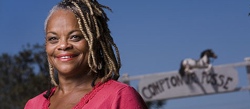 Horses have long served as a magical medium for the rehabilitation and uplifting of spirits and minds; equine therapy is frequently implemented as a social and vocational tool for the physically and mentally handicapped, former veterans, and inmates. In the 1992 film Into the West, a mysterious horse rescues two children from the poverty, hostility and discrimination of the projects of Ireland. Mayisha Akbar and riders from the Compton Junior Posse—a steadily growing group of kids from a Los Angeles suburb better known for gang violence than blue ribbons—are finding that their equine companions have an innate power to inspire them to dream of lives beyond gang involvement, just like the supernatural horse of the film. Changing the greater perceptions of the equestrian community, these new additions to the Southern California hunter and dressage arenas are really turning heads.
Horses have long served as a magical medium for the rehabilitation and uplifting of spirits and minds; equine therapy is frequently implemented as a social and vocational tool for the physically and mentally handicapped, former veterans, and inmates. In the 1992 film Into the West, a mysterious horse rescues two children from the poverty, hostility and discrimination of the projects of Ireland. Mayisha Akbar and riders from the Compton Junior Posse—a steadily growing group of kids from a Los Angeles suburb better known for gang violence than blue ribbons—are finding that their equine companions have an innate power to inspire them to dream of lives beyond gang involvement, just like the supernatural horse of the film. Changing the greater perceptions of the equestrian community, these new additions to the Southern California hunter and dressage arenas are really turning heads. The Compton Junior Posse is a 501.3.c. non-profit dedicated to encouraging inner city and underprivileged youth to become productive members of society. Using horses and horseback riding to teach responsibility, discipline, and self-esteem, founder Mayisha Akbar has managed to change the lives of hundreds of inner-city kids. This equine medium teaches them valuable social and interactive skills, motivates them to set both academic and career goals, as well as simply providing a place where they can seek refuge from the often violent environments in their neighborhoods. Out of her small, backyard stable, Akbar has seen two decades of kids grow into leaders and outstanding contributors to their local communities. “We have found that investing in these children through our equestrian program motivates our kids to achieve their goals,” she says. Akbar has also rescued over 100 horses through her ranch.
The Compton Junior Posse is a 501.3.c. non-profit dedicated to encouraging inner city and underprivileged youth to become productive members of society. Using horses and horseback riding to teach responsibility, discipline, and self-esteem, founder Mayisha Akbar has managed to change the lives of hundreds of inner-city kids. This equine medium teaches them valuable social and interactive skills, motivates them to set both academic and career goals, as well as simply providing a place where they can seek refuge from the often violent environments in their neighborhoods. Out of her small, backyard stable, Akbar has seen two decades of kids grow into leaders and outstanding contributors to their local communities. “We have found that investing in these children through our equestrian program motivates our kids to achieve their goals,” she says. Akbar has also rescued over 100 horses through her ranch. Early in the riding program, the Compton Junior Posse went mostly to rodeos. Akbar started to integrate English-style riding about three years ago after watching a flat class at a local horse show. “It was clearly so good for the horses to learn and progress the same way, and be judged the same way. Everyone walked, trotted, and cantered at the same time!” she noted, a big difference from rodeo chaos. Now, the Compton Junior Posse is primarily an English operation, and all of the rescue horses are trained under English saddle. Akbar says that since making the switch to English riding, she has seen Junior Posse riders benefit from more structure and discipline. “I was worried about not being accepted at hunter and dressage shows,” says Akbar, “but the English world has been so welcoming, so giving, and so warm! Everywhere we go we break norms. Everyone is so impressed with the athleticism and politeness of the Junior Posse riders—we are completely breaking equestrian stereotypes.”
Early in the riding program, the Compton Junior Posse went mostly to rodeos. Akbar started to integrate English-style riding about three years ago after watching a flat class at a local horse show. “It was clearly so good for the horses to learn and progress the same way, and be judged the same way. Everyone walked, trotted, and cantered at the same time!” she noted, a big difference from rodeo chaos. Now, the Compton Junior Posse is primarily an English operation, and all of the rescue horses are trained under English saddle. Akbar says that since making the switch to English riding, she has seen Junior Posse riders benefit from more structure and discipline. “I was worried about not being accepted at hunter and dressage shows,” says Akbar, “but the English world has been so welcoming, so giving, and so warm! Everywhere we go we break norms. Everyone is so impressed with the athleticism and politeness of the Junior Posse riders—we are completely breaking equestrian stereotypes.”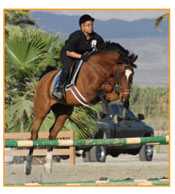 With the support of private donations, the Compton Junior Posse has grown from a refuge of necessity to a flourishing equestrian, husbandry, and educational program. Once on the verge of retiring due to the emotional toll of her work (Akbar estimates she’s lost 40 children over 20 years to gang violence), she has rallied in a most interesting way—by having introduced English style riding and equitation to the Junior Posse and finding support in some of the West Coast’s most prominent riders, trainers and veterinarians. She has forged ahead with a development plan for fundraising, support and maintenance of the program and now has some substantial goals, such as being the first inner city charter school and Interscholastic Equestrian League (IEL) team so students will be able to ride and receive PE credit from Junior Posse participation while they get core credits from regular schools. Additionally, as IEL participants, the members of the Compton Junior Posse would earn points toward collegiate equestrian scholarships when competing at IEL shows.
With the support of private donations, the Compton Junior Posse has grown from a refuge of necessity to a flourishing equestrian, husbandry, and educational program. Once on the verge of retiring due to the emotional toll of her work (Akbar estimates she’s lost 40 children over 20 years to gang violence), she has rallied in a most interesting way—by having introduced English style riding and equitation to the Junior Posse and finding support in some of the West Coast’s most prominent riders, trainers and veterinarians. She has forged ahead with a development plan for fundraising, support and maintenance of the program and now has some substantial goals, such as being the first inner city charter school and Interscholastic Equestrian League (IEL) team so students will be able to ride and receive PE credit from Junior Posse participation while they get core credits from regular schools. Additionally, as IEL participants, the members of the Compton Junior Posse would earn points toward collegiate equestrian scholarships when competing at IEL shows.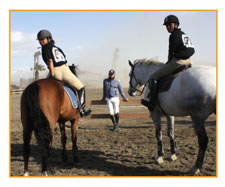 In the next year, Akbar’s goal is to raise 1 million dollars in gap funding while she awaits approval for federal and state grant money—primarily to hire a staff to support her efforts as the program grows. “I’m going to need a director of education, a director for the riding program, ranch management, an administrative coordinator, and capital for equipment, a hay barn, tractor, and classroom,” she says. She has also arranged for a long-term lease for her property so that the program can stay in its original location, which makes it convenient for the participants and their families. This evolving program that aspires to give more opportunities to inner city kids offers a new lease on life through horses and English riding. An unlikely bond that we hope can be everlasting.
In the next year, Akbar’s goal is to raise 1 million dollars in gap funding while she awaits approval for federal and state grant money—primarily to hire a staff to support her efforts as the program grows. “I’m going to need a director of education, a director for the riding program, ranch management, an administrative coordinator, and capital for equipment, a hay barn, tractor, and classroom,” she says. She has also arranged for a long-term lease for her property so that the program can stay in its original location, which makes it convenient for the participants and their families. This evolving program that aspires to give more opportunities to inner city kids offers a new lease on life through horses and English riding. An unlikely bond that we hope can be everlasting.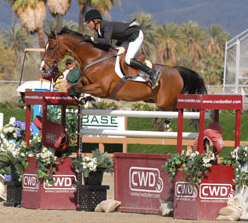 Sunday, March 16th
Sunday, March 16th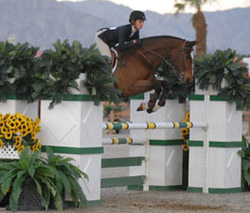 Congratulations also to Tache Rouge and John French on their win in the $10,000 ASG Software Solutions/USHJA International Hunter Derby Classic topping a talented field of handy hunters. Held under the lights in the Grand Prix arena, professionals, amateurs and juniors competed in this special class. Under the scrutiny of four judges, the top 12 horses hunted around two rounds of courses that included a snake option jump, liverpool, trot fence and the anticipated long gallop to the last oxer.
Congratulations also to Tache Rouge and John French on their win in the $10,000 ASG Software Solutions/USHJA International Hunter Derby Classic topping a talented field of handy hunters. Held under the lights in the Grand Prix arena, professionals, amateurs and juniors competed in this special class. Under the scrutiny of four judges, the top 12 horses hunted around two rounds of courses that included a snake option jump, liverpool, trot fence and the anticipated long gallop to the last oxer. We’ve listed the Desert Circuit Champions and Reserve Champions by division below – congratulations to all the exhibitors and we wish you continued success throughout the 2008 show season.
We’ve listed the Desert Circuit Champions and Reserve Champions by division below – congratulations to all the exhibitors and we wish you continued success throughout the 2008 show season.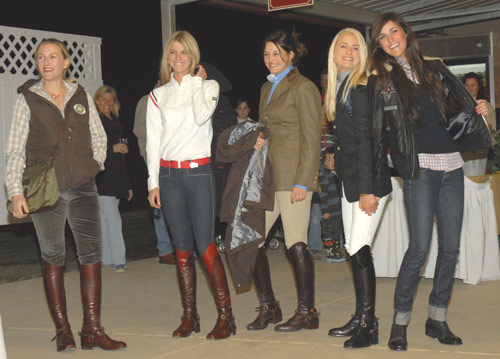
 HOW MUCH: No entry fee. The Relay class is limited to the first 12 teams that sign up and submit their entries in the HITS Show Office.
HOW MUCH: No entry fee. The Relay class is limited to the first 12 teams that sign up and submit their entries in the HITS Show Office.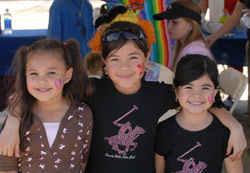
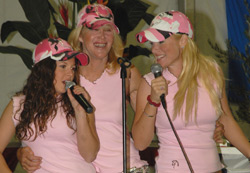
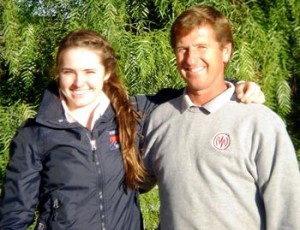 After watching her fellow Californian Aurora Griffin move to 1.50m and win Individual Bronze at Young Riders, Team Gold, Double Gold at Harrisburg, in addition to the William Steinkraus Style of Riding Award, Zazou decided it was an opportune time to ask Aurora and her trainer a few questions.
After watching her fellow Californian Aurora Griffin move to 1.50m and win Individual Bronze at Young Riders, Team Gold, Double Gold at Harrisburg, in addition to the William Steinkraus Style of Riding Award, Zazou decided it was an opportune time to ask Aurora and her trainer a few questions.